
Guide to Competitive Backlink Analysis
The author's views are entirely their own (excluding the unlikely event of hypnosis) and may not always reflect the views of Moz.
Using link data, although it can never be perfectly accurate, allows you to take a more scientific approach to your SEO strategies. How can we leverage link data for actionable insights? I recently wrote a post breaking down the Mormon SEO strategy, which is a very well thought out plan of action.. There seemed to be a lot of interest in the tools I used and the insights they provided. It's impossible to cover all scenarios, but my hope is to show how this data can be used.
Tools Used
- Excel
- SEOmoz API / Open Site Explorer
- Free Version of Majestic SEO
- Ninja Skills (prerequisite of working at Distilled)
For most of this post, I’m going to look at the SERPS for "nashville real estate", a competitive result from my hometown.
The Data Set
To start, I pulled a wide range of link based metrics from the Top 10.

Caveats: Your may want to remove large domains and exact match domains from your analysis. Large domains with solid brands may just add noise to your analysis. Exact match domains may be getting a substantial boost and may skew your analysis as well. I have removed both Trulia and Yahoo Real Estate from this set.
Data
- PA – Page Authority, metric from SEOmoz
- P LRD – Number of Linking Root Domains to the PAGE
- DA – Domain Authority, metric from SEOmoz
- R LRD - Number of Linking Root Domains to the DOMAIN
- Links – Raw number of links (SEOmoz data)
- Deep Links - % of root domains that link to content that isn’t home page
- mR – mozRank, SEOmoz’s metric similar to PageRank
- DmR – Domain mozRank, similar to mR, but on a DOMAIN level
- DmT – Domain mozTrust, SEOmoz metric to measure TrustRank
- EA LRD – Number of Linking Root Domains using EXACT match anchor text
- EA % - Percentage of anchors with EXACT match anchor
All of this information was acquired from SEOmoz’s data set. Items like deep links %, exact match linking root domains, and percent of anchors with exact match anchor were all obtained with some basic analysis. Now that we have our first data pull, we can dig in and talk about what these mean.
Breakdown the Top 10
If my goal is to break into the top 10, I’ll line my site’s metrics up against the trending of the top 10 and their averages. This will identify areas where I’m over- or under-performing. In addition to comparing against the average, I can look at the distribution of metrics across the top 10. I’ll throw out a few examples in this niche that jump out. The factors I look into may depend on the data pulled for a niche.
Link Root Domains
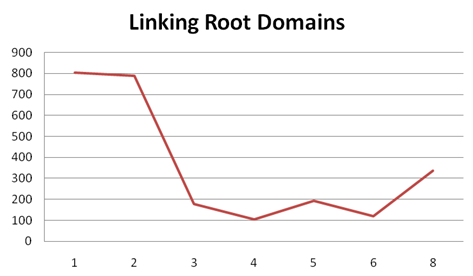
As we know, the number of linking root domains correlates well with rankings. This why in my link builder tips post I suggested getting a link, or just a few, and moving on from a domain. The majority of the sites in this niche sit around 100 to 200 unique linking domains. This graph gives you a gauge for breaking into the top 10 results. However, the top two results have pulled away from the rest with around 800 unique linking domains, so ranking number one may be difficult.
Exact Match Anchor Linking Root Domains
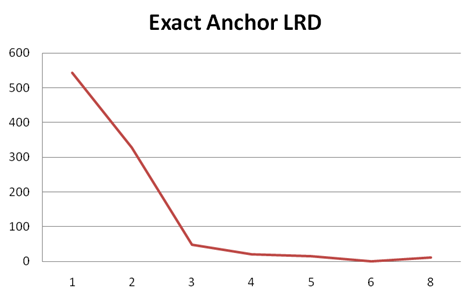
This metric was measured by looking at the Anchor Text Distribution tab on Open Site Explorer. I was a bit surprised by the results. The number one site has managed to receive links from 544 domains with the exact anchor text “Nashville Real Estate.” Regardless of how they managed to do so, this makes it a highly competitive term to rank number one for. However, it also shows that the majority of the Top 10 do not have a large number of domains linking with well-optimized links for this phrase. This graph, and the one before, shows opportunity exists for this keyword between result 3 and 10. This is why it’s important to note the distribution as well as the average.
Percent of Anchors with Exact Match Domains
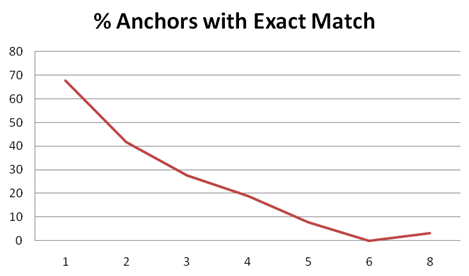
Looking at the percentage of anchors using this exact match phrase can provide some interesting insights. First, the top-ranking sites are excessively optimizing their link’s anchor text. Second, Google is allowing this significant optimization. Even the third result has nearly 30% of their links using this anchor text. Your link building strategy here could be aggressive without sticking out. Additionally, these sites are overly focused on one golden phrase. I’d have to dig deeper, but this may be indicative of several open opportunities in mid to longtail phrases. I’d likely take advantage of this short-sighted targeting strategy by first focusing on picking up the terms they’re ignoring.
Strategy
To rank well in this niche, you’re going to need a large number of links from a diverse set of domains. Google seems to be forgiving of over-optimization and has allowed aggressive link building. The first ranked site appears to sufficiently answer the query, so I don't think there is a reason to not allow it. Most of these sites do not have significant content strategies pulling links to subpages and most do not engage heavily in social media. Although an aggressive strategy would not stick out in this market, I'd caution again the aggressiveness of having almost 70% of your link profile with the same anchor text. This type of optimization is dangerous, limiting and ignores many other phrases.
Link Profiling
Dr. Pete wrote a great post on link profiling, which allows you to see the distribution of inbound links to a domain. This will give you insights on the quality of the links a site has acquired. I also use this when reporting the links I’ve built to my clients to visually demonstrate the distribution of links I've acquired. I’m going to briefly show an example of this profiling using Page Authority, but I repeat this with metrics such as Domain Authority, mR, DmR, and DmT. Disparities in these distributions can draw your attention to items you might not have considered.
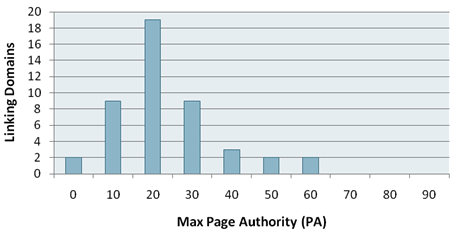
Radar Graphs
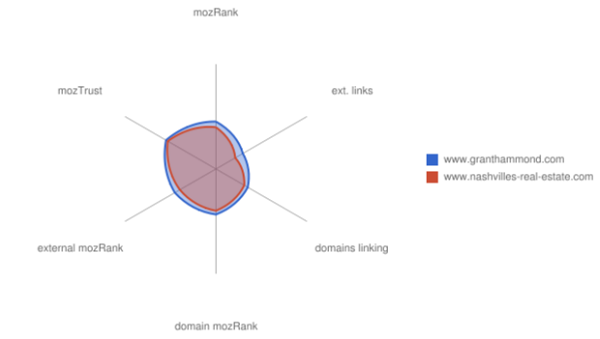
Not a new tool, but I like the radar graphs in SEOmoz Labs. These are great for demonstrating link analysis or providing a quick audit on a phone call or email. Let’s say the #12 ranked site nashvillebuyers.com called up and quickly wanted to know what it’d take to break into the Top 5. This quickly shows they're falling short on several significant ranking factors. This could also show that they’re beating other sites in all metrics. If this is the case, I might start looking at other factors like anchor text, anchor text distribution, link quality, and on-site targeting.
Top Content
After looking at a site’s links, it’s important to evaluate what’s the top content drawing in links. One of the best guides I’ve seen about visualizing this analysis is the post What Are My Most Linked to Subfolders? written by SEOgadget. This report can be pulled from Open Site Explorer’s Top Pages. In my Mormon SEO strategy post, I used the SEOmoz API and created a pivot table to find the most linked to content in their massive link profile.
Keyword Tag Cloud
A tag cloud of anchor text is a quick way to visualize the distribution of keyword anchors and pull out the terms being targeted. The most interesting anchor cloud I’ve seen so far is that of the Mormon LDS church.
To get this, I pulled the max number of links from the SEOmoz API, saved the list of anchors to a text file, and uploaded them to Tagxedo. Doing this quickly highlights major targeted terms and visually demonstrates the distribution of anchor text.
Broken Links
Another quick check that can bring you big wins is checking sites for 404 pages by looking at Open Site Explorer’s Top Pages tab. (Hopefully this isn't new to you guys, but worth mentioning.)

Reasons to Find Broken Links
- Great way to start a relationship with a webmaster: let them know, people like to reciprocate.
- Contact the people who are linking to them and get that link.
- Generate content ideas based off that type of content that has acquired links before.
- Recreate this content and get websites to switch the link.
Link Growth / Velocity
One more check I like to make is link growth rate. Aaron Wall wrote an article a while back about link velocity and the role link growth rates has on your link profile. MajesticSEO provides these graphs up for free and they can provide some interesting feedback. They provide link discovery and cumulative link graphs.

What we might be seeing here are a few strong pushes early on, followed by very little promotion in early 2007. At the start of 2008, the link building ramped up and remained constant. This is indicative of regular on-going link building, which is no surprise considering the optimization of these efforts. It’s also important to note that it ramped up even more during the last half of 2010. If this was your competitor’s profile, this is valuable information to have. This link growth rate makes this site even more competitive.

Now a profile like this is a bit more expected. They seem to have had a strong push at one time, but the link acquisition has faded over time. They have periods of spiky growth and have had minimal link growth in the last part of 2010.. This is a good sign if you’re looking to outrank this site.
Chopping Up The Link Export
One of the last few questions left is how and where are they getting these links. How can you chop up their link export to get actionable insights and link prospects? Let me just cover a few quick ideas.
Export CSV from Open Site Explorer, open it in Excel.
Filters & Sorts
- Filter Sites with Exact Match AND Phrase Match Anchor
- Filter by Branded Anchors and People's Names
- Sort by PA to get strongest PAGES
- Sort by DA to get strongest DOMAINS
Questions to Ask
- What content is attracting these links?
- What types of sites are these links from?
- Are they manually building these links? (directories, articles, guest blogging)
- Do they appear to be paid?
- What's the IP address and WHOIS information on anything fishy?
- What strategy is working here? Or is there even a strategy?
- Where are they getting the branded and name links?
- What communities are they participating in?
Perform a search against page title and URL
- How many links come from pages about same keyword?
- How many links include mentions like directory, links, resource, article, forum, etc?
Export into Google Custom Search
Yahoo use to allow you to perform search queries against a link profile's content. However, with the death of the Yahoo! linkdomain, this is not longer possible. Luckily, you can use Open Site Explorer and GCSE to do the same thing.
Search Ideas
- Sponsorships queries
- Paid link footprints
- Blogging footprints
- Person’s name
- Brand name
- Forum footprints
- Embed footprints
There a lot of different queries you can run, these may depend on what information you’re looking to get.
Although this is not an exhaustive look at analysis techniques, I hope it helps give insights into how link data can be used to create a strategy or understand your competition. Feel free to find me on Twitter if you ever want to chat more about link analysis.




Comments
Please keep your comments TAGFEE by following the community etiquette
Comments are closed. Got a burning question? Head to our Q&A section to start a new conversation.